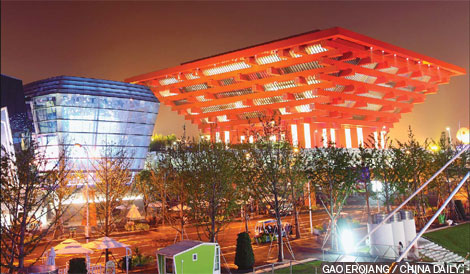|

Domestic and overseas tourists marvel at how the China Pavilion captures the country's past, and points to its promising future, Wu Yiyao reports.
The China Pavilion, which celebrates its national pavilion day at the Expo on Oct 1, draws 50,000 visitors every day with its striking exterior and vast exhibition of cultural relics.
"The China Pavilion is perhaps the most beautiful building I've ever seen," said Huang Yunjiao, a 12-year-old student from Hubei province.
"The highlights, for me, were the bronze chariot from the Qin Dynasty (221-206BC) and the animated version of the famous painting, Riverside Scene at the Qingming Festival," she said.
When Huang got inside the pavilion after waiting for three hours, she skipped several exhibits and walked directly to the famous scroll painting.
"It was amazing," she said. "I didn't know that camels used to serve as a means of transport in the Song Dynasty (960-1279) capital, until I saw them illustrated as such in the picture."
Xu Hubin, the director of the pavilion, credits its popularity to effective media promotion and well-designed displays.
"Visitors form other countries also appreciate it, because it provides insights into China as a culture and as a nation," he said. "We also have a huge amount of space to play with, so we were able to use a range of methods to display a lot of artifacts and information."
The pavilion has proven a magnet for Chinese tourists over the last five months due in no small part to the patriotic pride it inspires.
"Whether you think it looks sensational or not, I feel proud when I see this building," said Shu Weiqing, a visitor who was busy photographing the outside of the "Oriental Crown".
"Although life is still hard for many Chinese people, this pavilion tells us that we're living in a country with power and potential. Who wouldn't want to live in such a place?"
Overseas guests concurred that the pavilion not only pays testament to China's past but its bright future.
"I think it shows that Chinese people are accepting their past, despite all the memories of hardship, and they are now looking forward to a better future," said Austria's Catherina Muller. "I also appreciate the idea of celebrating diversity it conveys."
Some Asian tourists described visiting the pavilion as a sentimental experience that stirred up bittersweet memories.
Forty-seven-year-old accountant Tse Yat-Chow left China 24 years ago and now resides in Singapore. He said the display titled "Shared Moments", which shows scenes from typical mainland families, reminded him of his childhood.
"You can't find displays like this anywhere else," he said. "My memories of 'normal' family life ended when I left China, so I came here hoping to find some traces of what I'd lost, which was really nice."
Tse said he enjoyed watching the pavilion's eight-minute movie, which educates visitors about the changes China's cities and their people have experienced over the last 30 years.
However some of the exhibits challenge conventional ideas about what it means to lead a happy life, said Zhang Jufen, a 56-year-old Shanghai local resident. She said that discussions with other Chinese visitors taught her that not everyone thinks Shanghai is the best city in China in which to live; quite the opposite, in fact.
"I chatted to people who come from small villages and towns that I'd never heard of before, and I was surprised to find that they seemed happier with their lives than many of my neighbors," she said.
Zhang said it took her a long time to locate Shanghai among the hundreds of city names written on the floor in one part of the pavilion.
"I thought I knew the names of all the big cities in China from watching the news and the national weather forecast, but there are just so many," she said.
Some visitors to the Expo 2010 Shanghai have complained that there is a trend among the national pavilions to present their countries in innovative ways that leave their guests feeling bewildered about the content, despite being wowed by the style. Xu said that, in contrast, the China Pavilion had worked to make itself easily comprehensible to everyone.
(China Daily 10/01/2010)
|